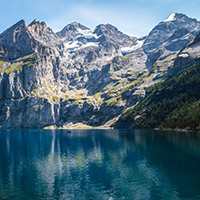Modelling physical and ecological processes in medium-to-large deep European perialpine lakes: a review

Accepted: 5 October 2021
HTML: 125
All claims expressed in this article are solely those of the authors and do not necessarily represent those of their affiliated organizations, or those of the publisher, the editors and the reviewers. Any product that may be evaluated in this article or claim that may be made by its manufacturer is not guaranteed or endorsed by the publisher.
Authors
In this paper we review a significant sample of the modelling studies carried out on medium-to-large deep European perialpine lakes (MLDEPLs). The reviewed bibliographic corpus was obtained querying Elsevier’s Scopus® database with a tailored search string on 8 January 2021. Results were filtered, accepting only journal papers written in English dealing with natural lakes having surface area > 10 km2. A list of 75 works was obtained, published between 1986 and 2021. Most studies have been carried out on Swiss lakes (44 out of 75 papers), Lake Geneva being the most investigated environment. A significant positive correlation was found between lake surface area and volume and the number of dedicated papers, suggesting that scientific attention is higher for environments characterised by large dimensions and relevant socio-economic interests. Both the number of papers and their citation count have experienced an exponential growth in time, pointing to a rising interest in quantitative modelling applications, but also to the increasing availability and ease of use of numerical modelling tools. Among the 75 selected papers, 55 employ a hydrodynamic driver, used alone or coupled with an ecological module, while the remnant 20 works adopt an ecological-only model. Among the papers employing hydrodynamic models, the use of three-dimensional (3D) drivers is surprisingly slightly more frequent (28 papers) than that of one-dimensional (1D) ones (26 papers), with most 3D applications having been published in the last 2011-2020 decade (24 papers). This reflects the interest on the hydrodynamic processes leading to the observed spatial heterogeneities in the biochemical properties of the MLDEPLs. However, coupling of ecological modules with 3D hydrodynamic drivers, to directly simulate these phenomena, is still restricted (2 papers) compared to that of 1D hydrodynamic drivers (8 papers), due to calibration and computational difficulties, which could be strongly reduced by future research achievements. Nevertheless, 1D models allow performing long-term prognoses considering multiple climate change and watershed management scenarios, due to their much smaller computational burden. The largest group of works dealing with ecological-only models (6 papers) is dedicated to applications of phosphorus budget models, which can above all be used to forecast variations in lake productivity in response to changes in the availability of the limiting nutrient.
Graphical abstract
How to Cite

This work is licensed under a Creative Commons Attribution-NonCommercial 4.0 International License.
Similar Articles
- BRUNO PETRICCIONE, ROSARIO MOSELLO, ALDO MARCHETTO, PREFACE , Journal of Limnology: Vol. 61 No. s1 (2002): National Programme for Forest Ecosystems Control CONECOFOR
- Hajar Taherisoudejani, Erica Racchetti, Fulvio Celico, Marco Bartoli, Application of QUAL2Kw to the Oglio River (Northern Italy) to assess diffuse N pollution via river-groundwater interaction , Journal of Limnology: Vol. 77 No. 3 (2018)
- Anamarija Ridl, Marina Vilenica, Marija Ivković, Aleksandar Popijač, Ignac Sivec, Marko Miliša, Zlatko Mihaljević, Environmental drivers influencing stonefly assemblages along a longitudinal gradient in karst lotic habitats , Journal of Limnology: Vol. 77 No. 3 (2018)
- Roy THOMPSON, Christian KAMENIK, Roland SCHMIDT, Sergi PLA, Maria RIERADEVALL, Jordi CATALAN, Testing a new multigroup inference approach to reconstructing past environmental conditions , Journal of Limnology: Vol. 67 No. 2 (2008)
- José BARQUÍN, Russell G. DEATH, Downstream changes in spring-fed stream invertebrate communities: the effect of increased temperature range? , Journal of Limnology: Vol. 70 No. s1 (2011): Springs: neglected key habitats for biodiversity conservation
- Antonella LUGLIÈ, Yelda AKTAN, Paola CASIDDU, Nicola SECHI, The trophic status of Bidighinzu Reservoir (Sardinia) before and after the diversion of waste waters , Journal of Limnology: Vol. 60 No. 2 (2001)
- Murat KAYA, Diego FONTANETO, Hendrik SEGERS, Ahmet ALTINDAĞ, Temperature and salinity as interacting drivers of species richness of planktonic rotifers in Turkish continental waters , Journal of Limnology: Vol. 69 No. 2 (2010)
- Kimio Hirabayashi, Makoto Ichikawa, Shunsuke Okada, Masaru Yamamoto, Change of macrobenthic communities in the 1930s, 1970s and 2015 in the mesotrophic Lake Nojiri, Central Japan , Journal of Limnology: Vol. 77 No. s1 (2018): Recent advances in the study of Chironomidae: An overview
- Maya P. BHATT, Toshiyuki MASUZAWA, Mineko YAMAMOTO, Nozomu TAKEUCHI, Chemical characteristics of pond waters within the debris area of Lirung Glacier in Nepal Himalaya , Journal of Limnology: Vol. 66 No. 2 (2007)
- Francesco ALIANIELLO, Francesco A. BIONDI, Cinzia FERRARI, Girolamo MECELLA, Luigi NISINI, Forest soil conditions in the CONECOFOR Permanent Monitoring Plots and in the Level I Network in Italy , Journal of Limnology: Vol. 61 No. s1 (2002): National Programme for Forest Ecosystems Control CONECOFOR
<< < 61 62 63 64 65 66 67 68 69 70 > >>
You may also start an advanced similarity search for this article.
-
Andrea Fenocchi, Nicolò Pella, Diego Copetti, Fabio Buzzi, Daniele Magni, Nico Salmaso, Claudia DrestiJournal of Contaminant Hydrology : 2025
-
Paolo Dezuanni, Diego Copetti, Claudia Dresti, Nicolò Pella, Fabio Buzzi, Andrea FenocchiFrontiers in Environmental Science : 2025
-
Laura M. V. Soares, Olivia Desgué‐Itier, Cécilia Barouillet, Céline Casenave, Isabelle Domaizon, Victor Frossard, Nelson G. Hairston, Andrea Lami, Bruno J. Lemaire, Georges‐Marie Saulnier, Frédéric Soulignac, Brigitte Vinçon‐Leite, Jean‐Philippe JennyLimnology and Oceanography Letters : 2025
-
Diego CopettiResources : 2023
-
Andrea Fenocchi, Fabio Buzzi, Claudia Dresti, Diego CopettiEcological Indicators : 2023
-
L.M.V. Soares, M. Thouillot, V. Frossard, O. Desgué-Itier, C. Barouillet, Y. Baulaz, J.-C. Clément, I. Domaizon, J.-M. Dorioz, C. Goulon, J. Guillard, S. Jacquet, E. Réalis, V. Tran Khac, J.-P. JennyEcological Indicators : 2025

 https://doi.org/10.4081/jlimnol.2021.2041
https://doi.org/10.4081/jlimnol.2021.2041




